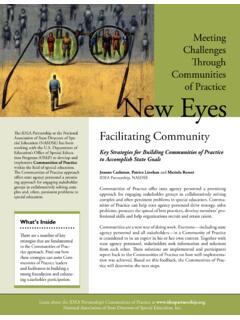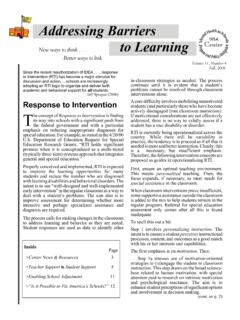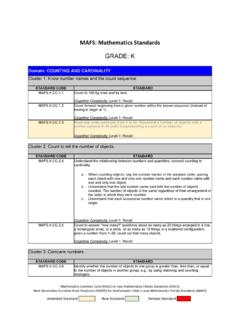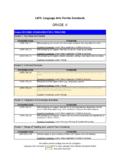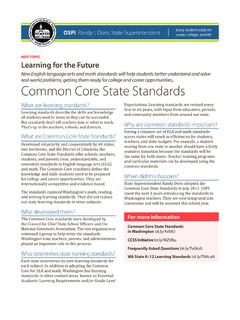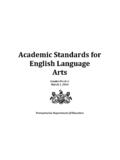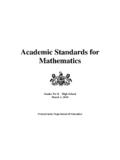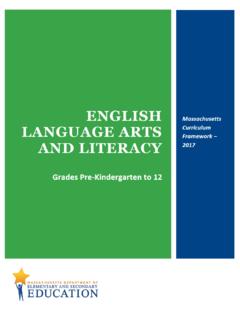Transcription of Common Core State Standards - IDEA Partnership
1 Common core State Standards and Students with Disabilities January 2014 IDEA Partnership 1 IDEA Partnership 2 The IDEA Partnership extends appreciation to, and acknowledges the contributions of, xx cross-stakeholders representing Teachers, General Education Administrators, Special Education Administrators, Specialized Instructional Support Providers, Families, Higher Education, Technical Assistance Providers, and Policymakers from 24 states across the country, in the creation of this presentation -and- is deeply grateful for being allowed to adapt slides originally created by the Council of Chief State School Officers, Partnership for Assessment of Readiness for College and Careers.
2 Smarter Balanced Assessment Consortia, and the Assessing Special Education Students Collaborative presented at the Office of Special Education Programs Project Directors Meeting, July 2012. January 2014 IDEA Partnership 3 Agenda Common core State Standards Application to students with disabilities High quality instruction IEP development State assessments Resources for more information January 2014 To Disparate Standards across states Student mobility Skills needed for today s jobs/careers Global competition January 2014 IDEA Partnership 4 Grounded in evolving sense of reasonable benefit Informed by growing knowledge of instruction Guided by statute and regulation reauthorizations Consistent with education reform Aligned with disability policy direction across the lifespan Common core State Standards and
3 Students with Disabilities January 2014 IDEA Partnership 5 College/Career Readiness: anchor for the Common core 1/2 of grads prepared for postsecondary ed Career-readiness and college-readiness K-12 Standards back-mapped January 2014 IDEA Partnership 6 January 2014 IDEA Partnership 7 Students with be challenged to excel within the general curriculum and be prepared for success in their post-school lives, including college and/or careers. Application to Students with Disabilities English / Language Arts Reading progressive development of skills and complexity of text access Writing logical argument and research Speaking and Listening purposeful in various situations Language vocabulary and conventions Media and Technology integrated throughout Literacy in the content areas emphasized at grade 6 and beyond January 2014 IDEA Partnership 8 Independence with text complexity Qualitative dimensions Quantitative dimension Reader and task considerations Value evidence in argument / different disciplines require different evidence ELA Significant Changes January
4 2014 IDEA Partnership 9 Mathematics Focus 2 to 4 concepts developed deeply in each grade level Coherence concepts logically connected from one grade level to the next to other major topics within the grade level Rigor Fluency with math facts Application of knowledge to real world situations Deep understanding of mathematical concepts January 2014 IDEA Partnership 10 Construct viable arguments and critique reasoning of others Use appropriate tools strategically; including technology Math Significant Changes January 2014 IDEA Partnership 11 Standards do Prescribe teaching strategies Cover all that can be taught Define advanced work Prescribe needed interventions and supports Cover everything for college- and/or career-readiness January 2014 IDEA Partnership 12 Students with disabilities are a heterogeneous group with one Common characteristic: the presence of disabling conditions that significantly hinder their abilities to benefit from general education (IDEA 34 , 2004).
5 Therefore, how these high Standards are taught and assessed is of the utmost importance in reaching this diverse group of students. January 2014 IDEA Partnership 13 Being Retrofit of the previous Standards movement Build on what we know Consider students with disabilities in all aspects of instruction in general and alternate assessments January 2014 IDEA Partnership 14 All students are general education students first. January 2014 IDEA Partnership 15 For SwD to meet Standards and demonstrate High-quality, evidence-based instruction Accessible instructional materials Embedded supports Universal Design for Learning Appropriate accommodations Assistive technology January 2014 IDEA Partnership 16 SwD in general education curricula Instructional strategies Universally designed units/lessons Individualized accommodations/modifications Positive behavior supports Service delivery options Co-teaching approaches Paraeducator supports January 2014 IDEA Partnership 17 More ways to More ways to More ways to demonstrate Potentially more progress the general education curriculum for all learners Universal Design
6 For Learning (UDL) Learner variability is the norm! Learners vary in the ways they take in information in their abilities and approaches across their development Learning changes by situation and context January 2014 IDEA Partnership 19 3 Networks = 3 UDL Principles 20 21 Change in instructional strategies that enable children to demonstrate their abilities in the classroom or assessment/testing setting; designed to provide equity, not advantage, for children with disabilities Appropriate Accommodations Critical Questions: What is needed beyond UDL? Has student been taught to use accommodation? Is the accommodation Used by the student?
7 Beneficial to the student? A barrier to student achievement? Enabling the student? January 2014 IDEA Partnership 23 Broad range of systemic and individualized strategies for achieving important social and learning outcomes while preventing problem behavior Positive Behavior Supports Behavior is learned Identify Teach Model Re-teach Teach Realistic Purposeful Cross environments Practice Physical Psychological Reinforce Internalized Expected Perform January 2014 IDEA Partnership 25 Most likely to drop Academic performance Low grades Low test scores F s in English and Math Few credits Retention Educational engagement Low engagement High absenteeism Poor school behavior Low extracurricular
8 Participation Poor relationships with teachers and peers January 2014 IDEA Partnership 26 RtI / multi-tiered systems of support Tier I: core ACADEMIC AND BEHAVIORAL INSTRUCTION; UNIVERSAL SUPPORTS; universal screening and INSTRUCTIONAL and BEHAVIORAL INTERVENTIONS Tier II: TARGETED INTERVENTIONS and progress monitoring Tier III: INTENSIVE INTERVENTIONS and progress monitoring Academic Behavior Significantly Low Underachievement Insufficient Response to Intervention January 2014 IDEA Partnership 27 A service delivery model in inclusive schools whereby two or more teachers are delivering substantive instruction to a diverse and blended group of students in a single classroom.
9 Co-teaching Co-teaching and Assisting Teaching Teaching Teaching and Observing Adapted from Friend and Cook January 2014 IDEA Partnership 29 Under the direction of a certificated teacher, and with appropriate training, supports student academic and behavioral expectations. Paraeducator Traditional Duties Monitor learners in non-academic environments Maintain learning centers Reinforce lessons introduced by teachers Provide personal physical assistance January 2014 IDEA Partnership 31 Provide instructional interventions Carry out behavior plans Assist with assessments Document learner performance Support safe learning environment Assist related service personnel Participate in IFSP, IEP, and ITP development January 2014 IDEA Partnership 32 Considering the CCSS.
10 How do we address the needs of students low or limited academic skills significant cognitive disabilities language-based disabilities any combination of learning challenges January 2014 IDEA Partnership 33 ? Demonstrating mastery Student learning standard Precursor skill Precursor skill Precursor skill Communication skills of student Attention skills of the student January 2014 IDEA Partnership 34 ELA example: informational text grade Determine the main idea of a text and explain how it is supported by key details; summarize the text In 3 paragraph text In 2 paragraph text In 1 paragraph text When in first sentence of paragraph In a sentence January 2014 IDEA Partnership 35 Math example: measurement Know relative sizes of measurement unites within one system of units ( , linear, weight, time) Identify yard Identify foot Determine foot is less than yard Identify inch Determine inch is less than foot January 2014 IDEA Partnership 36 Individualized Education Program.
